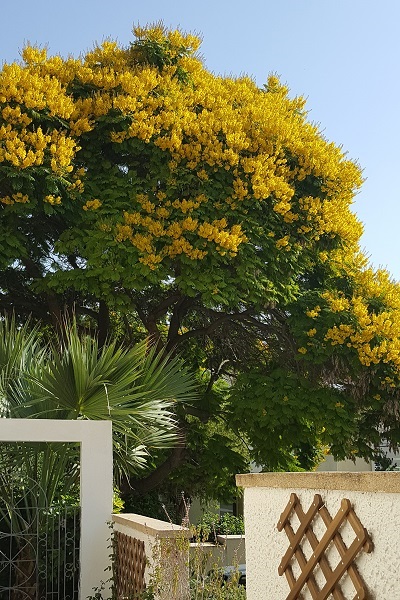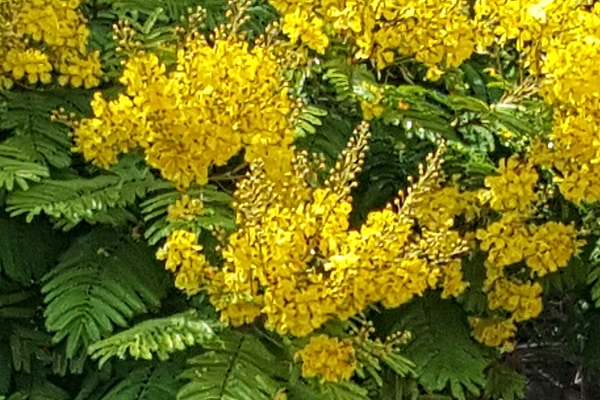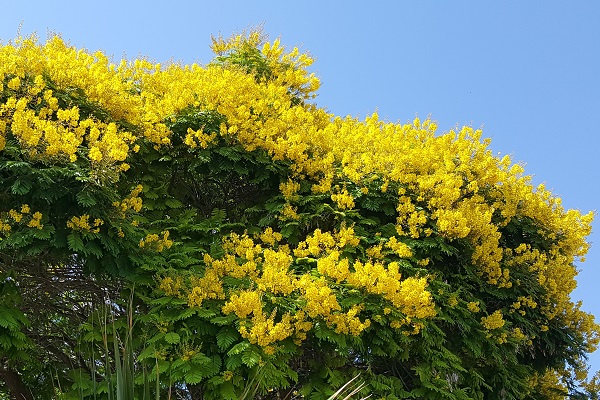Yellow Poinciana, Copperpod, Horsebush,
Hebrew: שלטית מקומטת, Arabic: بلتوفورم مجعد
| Scientific name: | Peltophorum dubium (Spreng.) Taub. | |
| Synonym name: | Baryxylum dubium (Spreng.) Pierre, Caesalpinia dubia Spreng., Peltophorum vogelianum Benth. | |
| Common name: | Yellow Poinciana, Copperpod, Horsebush | |
| Hebrew name: | שלטית מקומטת | |
| Arabic name: | بلتوفورم مجعد | |
| Family: | Fabaceae or Papilionaceae, Legume / Pea Family, משפחת הפרפרניים |

|
| Life form: | Semi-deciduous tree. In its native South America it is evergreen, but in colder regions (including most of Israel), it sheds its leaves. | |
| Stems: | Young stems with fine, dense, rusty-brown to greyish, closely appressed puberulence or pubescence, also with small, stalked, swollen-headed glands. | |
| Leaves: | Bipinnate (twice-compound) leaves are composed of small deep green leaflets that resemble the leaves of its relative – Delonix regia, the royal poinciana. | |
| Inflorescence: | A loose raceme, racemes often ± aggregated and panicled; bracts usually linear-lanceolate and deciduous. | |
| Flowers: | Hermaphrodite. Calyx-tube very short, lobes 5, imbricate, subequal, longer than the tube. Petals 5, subequal, the upper one often shorter than the others, ± spathulate, strongly imbricate. Stamens 10, declinate; filaments free, conspicuously brown- villous basally, glabrous above; anthers dorsifixed, dehiscing by longitudinal slits. Ovary sessile or subsessile, brown-pubescent or -tomentose, 2 to many-ovuled; style filiform, pubescent basally, glabrous above; stigma broadly peltate. | |
| Fruits / pods: | Flat brown pods; cylindrical seeds with hard nuts. | |
| Flowering Period: | July, August | |
| Habitat: | Planted mainly in gardens and large parks | |
| Distribution: | the Coastal Plain and the Lowlands | |
| Chorotype: | Southern America | |
| Summer shedding: | Perennating |

Derivation of the botanical name: Peltophorum, Greek pelta, a shield; phoreo, to bear; from the form of the stigma of these tropical trees. dubium, doubtful, in the sense of not following the genus pattern. Baryxylum, from barys, heavy, and zylon, wood; the wood of the tree is very heavy. Caesalpinia, named in honor of Andreas Caesalpini (1519 - 1603), an Italian botanist and physician to Pope Clement VIII. The Hebrew name: שלטית (Celtic), derived from the aristocratic signs that shield is the central element in them; the scar of the pestle is wide and flattened like a war shield. מקומטת (mekumetet),"wrinkled" by the wrinkled petals of the flowers.
Pollinators- Bees, Insects. 
|